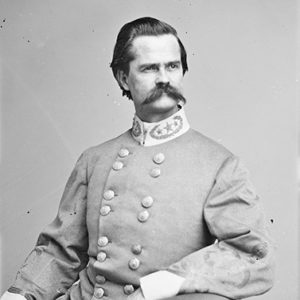calsfoundation@cals.org
Tenth Arkansas Infantry/Tenth Arkansas Cavalry (CS)
Two units known as the Tenth Arkansas Cavalry served in the Confederate army during the Civil War. Both served in the state late in the war and saw action in a number of engagements. A third unit known as Crawford’s First Arkansas Cavalry received an official designation as the Tenth Arkansas Cavalry but operated almost exclusively under the former name rather than the latter.
The first unit known as the Tenth Arkansas Cavalry began service as the Tenth Arkansas Infantry Regiment. Organized at Springfield (Conway County) in July 1861, the regiment consisted of companies from Conway, Van Buren, and Perry counties. Thomas Merrick served as the first colonel of the regiment. Merrick served as a general officer in the pre-war Arkansas militia and was involved with the surrender of the Little Rock Arsenal in February 1861.
After organizing, the regiment moved to Tennessee and then Bowling Green, Kentucky. A large number of the men fell ill during this period and were dispersed to hospitals throughout the South, with a number dying, including at least twenty from Company C and seventeen from Company H. Part of a brigade under the command of Brigadier General John Bowen, the Tenth served with units from Missouri and Mississippi, as well as the Ninth Arkansas. The regiment saw action at the Battle of Shiloh on April 6 and 7, 1862. Exact losses for the regiment are not known, but the brigade lost ninety-eight killed, 498 wounded, and twenty-eight missing.
Retreating with the rest of the Confederate army into Mississippi, the unit reorganized. A consolidation saw the ten companies of the regiment reduced to eight. Merrick faced charges related to the disorganized state of the unit and resigned in May. Captain Allen Rufus Witt of Company A became the new colonel of the regiment, as all three original field officers of the regiment were dropped from the roster.
The next year of service saw the unit posted to various locations in Mississippi and Louisiana, including Vicksburg. The regiment served at Ponchatoula, Louisiana, in the winter of 1862–1863, with Colonel Witt commanding the military post in the town. On October 22, 1862, the regiment reported 249 men present for duty.
In early 1863, the regiment joined the garrison at Port Hudson, Louisiana. Posted to a brigade under the command of Brigadier General Abraham Buford in March 1863, the Tenth served alongside units from Kentucky and Alabama. The Union army began to move against the outpost in the spring of 1863 in an effort to capture the Confederate garrison and open the Mississippi River to Federal use. During the early stages of the campaign, the regiment defended the eastern approaches to the fortifications near the community of Olive Branch. Another reorganization later in the spring saw the entire infantry and artillery garrison at Port Hudson divided into right, left, and center wings, with the Tenth Arkansas assigned to the left wing under the command of Colonel Isaiah George Washington Steedman. A final reassignment on May 15 saw the regiment assigned to the center wing under the command of Brigadier General William Beall, but reports filed after that date show that the regiment continued to serve under Steedman. Colonel Witt was captured near Port Hudson on May 28, and command of the unit fell to Lieutenant Colonel E. L. Vaughn.
Vaughn struggled to lead the regiment during the siege. On June 11, Steedman reported that the regiment could not be trusted to hold the position in the line. Members of the unit refused to take their places in the line, and Steedman blamed the officers of the regiment rather than the enlisted men. By early July, only one company of the regiment served on the line, with the other seven refusing. On July 7, a frustrated Steedman arrested Vaughn and placed Captain Steedman of Company K in command of the regiment. The entire garrison surrendered on July 9.
The enlisted men of the regiment were paroled within a few days, but the officers of the unit were transported to various military prisons. Some officers were later exchanged, but some remained in confinement until the end of the war.
The officers and men who were released from Federal custody returned to Arkansas, where they reorganized into a new unit. Witt escaped by jumping from a steamer in the Mississippi River and swimming to shore. The unit reorganized as a cavalry unit rather than an infantry unit and became known as the Tenth Arkansas Cavalry, also known as Witt’s Arkansas Cavalry, with the latter name used most often. Additional recruits joined the unit.
The unit saw action at numerous skirmishes, including at Tomahawk and Rolling Prairie. The unit did not participate in defensive efforts during the Camden Expedition, continuing to serve in east-central Arkansas. It did serve in Sterling Price’s raid into Missouri and Kansas in the fall of 1864. After the failure of the attack, the unit continued to serve in Arkansas, seeing action at the Skirmish at Lewisburg in Conway County on February 12, 1865. The unit ended the war on May 28, 1865, when it contacted Federal authorities to request terms of surrender.
Another unit serving late in the war was known as Newton’s Tenth Arkansas Cavalry. Composed of militia companies from southern Arkansas, the core of the unit originally served as a battalion under the command of Lieutenant Colonel Allen Pettus. The battalion included companies from Hempstead, Clark, Sevier, Polk, and Hot Spring counties raised in early 1864. This unit served at the Action at Marks’ Mills, where Pettus was killed. In late August 1864, the militia units were transferred to Confederate service and reorganized into a regiment with Colonel Robert C. Newton in command. Newton earlier led a regiment of cavalry comprising companies from north, east, and central Arkansas. Newton led the new unit in an attack on the steamer Alamo in November 1864, as well as the Skirmish at Boggs’ Mills. The unit concluded the war in southwestern Arkansas.
For additional information:
Dirck, Brian. “Witt’s Cavalry: An Arkansas Guerrilla Unit.” Faulkner Facts and Fiddlings 36 (Fall–Winter 1994): 63–76
National Park Service Civil War Soldiers and Sailors Database, 10th Regiment, Arkansas Infantry. https://www.nps.gov/civilwar/search-battle-units-detail.htm?battleUnitCode=CAR0010RI (accessed December 22, 2020).
David Sesser
Henderson State College
 Civil War through Reconstruction, 1861 through 1874
Civil War through Reconstruction, 1861 through 1874 Military
Military William Beall
William Beall  Robert C. Newton
Robert C. Newton  Sterling Price
Sterling Price 



Comments
No comments on this entry yet.